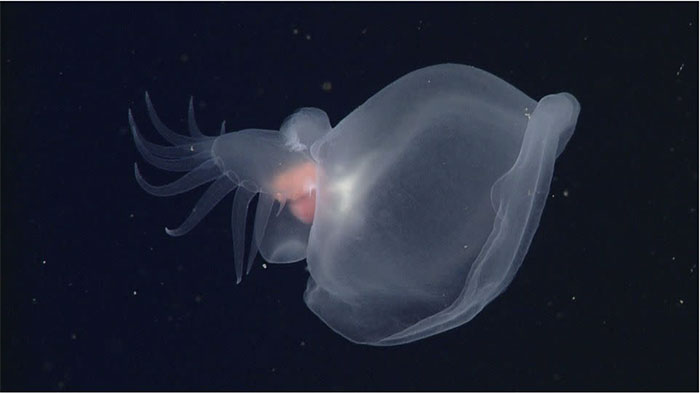Mysterious animal glowing in the dark ocean discovered
Researchers have discovered a new species in the ocean's "midnight zone." It's a mysterious mollusk that glows.
About the size of an apple, the new species has been named Bathydevius caudactylus and is classified as a sea slug. However, it is unlike any sea slug that scientists at the Monterey Bay Aquarium Research Institute (MBARI) have ever seen before.
Glowing animals under the ocean
Typically, sea slugs live on the seafloor or in coastal environments such as tide pools. Only a few are known to live in open water near the surface.
Meanwhile, Bathydevius lives in the ocean's "midnight zone", an area 1,000 to 4,000 meters below the ocean's surface. With a paddle-like tail and a large, soft, jelly-like head, they can glow through bioluminescence.

Bathydevius is a species of sea slug that can swim and glow using bioluminescence - (Photo: MBARI).
MBARI senior scientists Bruce Robison and Steven Haddock first encountered Bathydevius in February 2000 during a deep dive off Monterey Bay using the remotely operated robot Tiburon. Since then, they have made more than 150 observations of the 'mysterious mollusk . '
At first glance, Bathydevius 'looks more like a big megaphone with a feathery tail' than a sea slug, said study co-author Haddock. It also has a snail-like foot, which initially left researchers wondering exactly what kind of mollusk Bathydevius is.
A "unique" species
An underwater research robot discovered Bathydevius in waters off the West Coast of North America, from Oregon to Southern California.
Researchers from the National Oceanic and Atmospheric Administration have also observed a similar creature in the Mariana Trench, located in the western Pacific Ocean, suggesting that Bathydevius had a wider range than previously known.
The team collected a specimen to study further in the lab. The specimen's anatomy and genetics revealed that it was a sponge, but a specialized species that had adapted to catch prey and survive in the "midnight zone."
Almost every aspect of Bathydevius reflects adaptations to the 'midnight zone ,' from its anatomy, physiology, reproduction, feeding, and behavior. They move up and down in the water column by stretching their bodies or drifting with the current. They have both male and female reproductive organs. When they need to avoid predators, they rely on their transparent bodies to naturally conceal themselves.
And if threatened, Bathydevius glows to distract predators. The luminous particles that help create the 'starry' appearance on Bathydevius' back can be found in the species' tissues.
The study authors are concerned that deep-sea mining, which involves scooping up material from the seabed, could endanger Bathydevius . A study describing the new species has been published in the journal Deep Sea Research Part I.
- Video: Jellyfish in the deepest ocean ditch in the world
- The mysterious glowing stone in the night in Dong Nai
- Fish glowing egg-shaped
- 7 new species of glowing mushrooms have been discovered
- Close up of mysterious fireball in the sky of America
- The ocean will become a strange world every night
- The mysterious 'spooky' series in the ocean
- Detecting mysterious dark flows in the universe
- Beautiful glowing coast like fireflies in Maldives
- Scientists discovered poisonous frogs with glowing bones through the skin
- Mysterious blue ocean waves at midnight in California
- Discovered many mysterious creatures under the Pacific Ocean, some living up to 15,000 years old
 Surprised: Fish that live in the dark ocean still see colors
Surprised: Fish that live in the dark ocean still see colors Japan suddenly caught the creature that caused the earthquake in the legend
Japan suddenly caught the creature that caused the earthquake in the legend A series of gray whale carcasses washed ashore on California's coast
A series of gray whale carcasses washed ashore on California's coast Compare the size of shark species in the world
Compare the size of shark species in the world